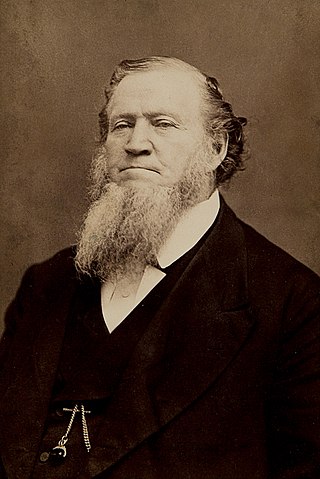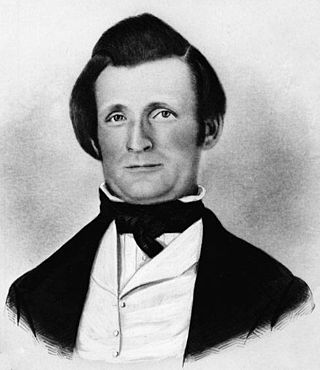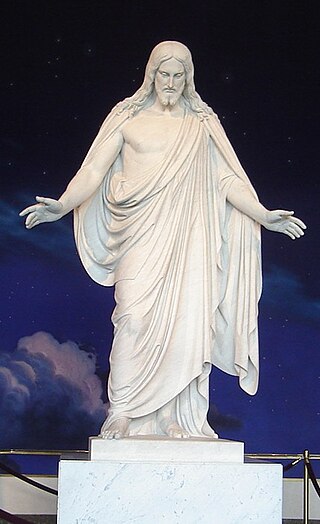
Brigham Young was an American religious leader and politician. He was the second president of the Church of Jesus Christ of Latter-day Saints, from 1847 until his death in 1877. During his time as church president, Young led his followers, the Mormon pioneers, west from Nauvoo, Illinois, to the Salt Lake Valley. He founded Salt Lake City and served as the first governor of the Utah Territory. Young also worked to establish the learning institutions that would later become the University of Utah and Brigham Young University. A polygamist, Young had at least 56 wives and 57 children. He formalized the prohibition of black men attaining priesthood, and led the church in the Utah War against the United States.

Elizabeth Ann Smith Whitney was an early Latter Day Saint leader, and wife to Newel K. Whitney, another early Latter Day Saint leader. She went by her middle name, Ann.

William Marks was an early leader in the Latter Day Saint movement and was a member of the First Presidency in the Reorganized Church of Jesus Christ of Latter Day Saints. Marks is mentioned in the Doctrine and Covenants in sections 117 and 124 of the Church of Jesus Christ of Latter-day Saints edition and in section 115 of the Community of Christ edition.
The succession crisis in the Latter Day Saint movement occurred after the murder of Joseph Smith, the movement's founder, on June 27, 1844.

William Wines Phelps was an early leader of the Latter Day Saint movement. He printed the first edition of the Book of Commandments that became a standard work of the church and wrote numerous hymns, some of which are included in the current version of the Church of Jesus Christ of Latter-day Saints' hymnal. He was at times both close to and at odds with church leadership. He testified against Joseph Smith, providing evidence that helped persuade authorities to arrest Smith. He was excommunicated three times and rejoined the church each time. He was a ghostwriter for Smith. Phelps was called by Smith to serve as assistant president of the church in Missouri and as a member of the Council of Fifty. After Smith's death, Phelps supported Brigham Young, who was the church's new president.

William H. Clayton was a clerk, scribe, and friend to the religious leader Joseph Smith. Clayton, born in England, was also an American pioneer journalist, inventor, lyricist, and musician. He joined the Church of Jesus Christ of Latter Day Saints in 1837 and served as the second counselor to the British mission president Joseph Fielding while proselyting in Manchester. He led a group of British converts in emigrating to the United States in 1840 and eventually settled in Nauvoo, Illinois, where he befriended Joseph Smith and became his clerk and scribe. He was a member of the Council of Fifty and Smith's private prayer circle.

Edward Stevenson was a prominent Latter-day Saint missionary of the 19th century. He also served as a general authority in the Church of Jesus Christ of Latter-day Saints as one of the seven presidents of the Seventy.
Joseph Smith: The Prophet of the Restoration is a 2005 film that focuses on some of the events during the life of Joseph Smith, founder of the Latter Day Saint movement, which was both filmed and distributed by the Church of Jesus Christ of Latter-day Saints. The film was shown in the Legacy Theater of the Joseph Smith Memorial Building from its opening on December 17, 2005 until early 2015, and opened in several LDS Church visitors' centers on December 24, 2005.

Zebedee Coltrin was a Mormon pioneer and a general authority in the Church of Jesus Christ of Latter-day Saints from 1835 to 1837. He served in later years as a patriarch in the church, from 1873 until his death.
George Miller was a prominent convert in the Latter Day Saint movement and was the third ordained bishop in the Latter Day Saint church.
Lyman Royal Sherman was an early leader in the Latter Day Saint movement, an inaugural member of the Seven Presidents of the Seventy, and was called to the Quorum of the Twelve Apostles but died before being informed and ordained.

Reynolds Cahoon was an early leader in Latter Day Saint movement and later, in The Church of Jesus Christ of Latter-day Saints. He was one of the inaugural members of the Council of Fifty, organized by Joseph Smith Jr in 1844.
George Donald Durrant is a prominent member of the Church of Jesus Christ of Latter-day Saints. He has written or co-authored more than 50 books, been a university professor, worked in several positions in the LDS Church Educational System, a motivational speaker, and an LDS Church employee. He has taught Religion at Brigham Young University (BYU), and his published books include "Love at Home, Starring Father" (1976).
Donald Quayle Cannon is a retired professor at Brigham Young University who specializes in Latter-day Saint history, particularly early Latter-day Saint history and international Latter-day Saint history.

Almon Whiting Babbitt was an early leader in the Latter Day Saint movement, a Mormon pioneer, and the first secretary and treasurer of the Territory of Utah. He was killed in a raid by Cheyenne Native Americans in Nebraska Territory while travelling on government business between Utah and Washington, D.C.
Steven Craig Harper is a professor of church history and doctrine at Brigham Young University. He was a historian for the Church History Department of the Church of Jesus Christ of Latter-day Saints. From 2019, he is the Editor-in-Chief of BYU Studies Quarterly.
The Religious Studies Center (RSC) is the research and publishing arm of Religious Education at Brigham Young University (BYU), sponsoring scholarship on the culture, history, scripture, and doctrine of the Church of Jesus Christ of Latter-day Saints. The dean of Religious Education serves as the RSC's director, and an associate dean oversees the two branches of the RSC: research and publications.
Seymour Brunson was an early convert to the Church of Jesus Christ of Latter-day Saints. He is most noted since it was at a speech given at his funeral that Joseph Smith first presented the doctrine of Baptism for the Dead.

The following outline is provided as an overview of and a topical guide to the Church of Jesus Christ of Latter-day Saints.

Martha Jane Knowlton Coray was an American Mormon pioneer, record keeper, and educator. She was the only female member of the first board of trustees of Brigham Young Academy. Born in Kentucky and raised in Ohio and Illinois, Coray converted to the Church of Jesus Christ of Latter-day Saints as a young woman and moved to the Mormon settlement of Nauvoo. There, she assisted Lucy Mack Smith, the mother of Joseph Smith, in creating a biography of Joseph, later published under the title History of Joseph Smith by His Mother. After crossing the Great Plains alongside other Mormon pioneers, Coray settled in Utah Territory, homesteading in towns such as Tooele and Mona. She helped support her family financially through dairy production, home chemistry, and other crafts. Though she never received formal schooling, Coray studied various topics in her free time and sought to teach her children what she knew. She took an interest in law, becoming involved in local court disputes and political discussions. Towards the end of her life, in 1875, Coray was appointed a member of the first Brigham Young Academy Board of Trustees, the only woman to serve in this capacity at the time. While serving as trustee, she focused her efforts on encouraging education for young women and creating a curriculum of religious education for the academy. Today, the lecture hall in the Karl G. Maeser Building on Brigham Young University's campus bears Coray's name, and the university's 1997 homecoming celebrations honored her achievements.











